

Trouver sa voie, c’est sacré. Investissement et dépense : comprenez les différences. Non, ne croyez pas lire un article entièrement dédié aux finances personnelles.
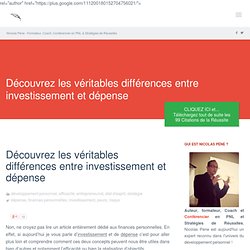
En effet, si aujourd’hui je vous parle d’investissement et de dépense c’est pour aller plus loin et comprendre comment ces deux concepts peuvent nous être utiles dans bien d’autres et notamment l’efficacité ou bien la réalisation d’objectifs. La dépense : Avant de traiter d’investissements, commençons tout d’abord par les dépenses. Qu’est-ce qu’une dépense ? D’un point de vue financier, ce serait employer votre argent pour l’achat d’un bien ou d’un service sans espérer y voir un quelconque retour.
Entreprendre c'est apprendre. Êtes-vous d’accord pour dire qu’entreprendre c’est apprendre?
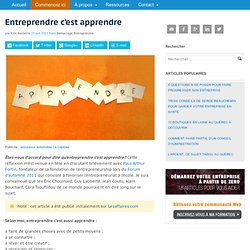
Cette réflexion m’est venue en tête en discutant brièvement avec Paul-Arthur Fortin, fondateur de la fondation de l’entrepreneurship lors du Forum d’automne 2011 qui consiste à favoriser l’entrepreneuriat à l’école. Je suis convaincue que les Éric Chouinard, Guy Laliberté, Jean Coutu, Alain Bouchard, Cora Tsouflidou de ce monde pourraient en dire long sur le sujet. Selon moi, entreprendre c’est aussi apprendre : Apprendre à entreprendre Lorsque j’ai interrogé mon entourage à savoir s’ils avaient appris plus en dehors de leurs études, plusieurs m’ont répondu que c’était le cas. Post-mortem – naissance, vie et mort de ma startup — #fail. [Attention, long article, donc long temps de lecture à prévoir – mettez-vous dans de bonnes conditions pour l’apprécier ou prévoyez une lecture ultérieure !]
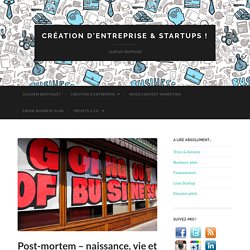
TL;DR En partant il y a presque 2 ans de l’incubateur HEC pour lancer une startup (sans encore en avoir l’idée fondatrice), je ne m’imaginais évidemment pas, 18 mois plus tard, m’être planté de manière aussi belle et « classique », perdant au passage un ami, de l’argent, la confiance de certains dans mon réseau, et quelques petits bouts d’égo. Cet article revient en détails sur le déroulé du projet, partage certains documents internes qui montrent les évolutions et pivots ainsi que quelques-unes de nos façons de travailler (et documente ainsi le démarrage, la vie et la mort d’une startup de manière assez transparente, ce qui me semble assez rare), et tente ensuite de mettre des mots — de mon point de vue personnel donc très subjectif — sur les leçons que j’en retire.
Sur le papier, tout va alors bien. Calendrier des “faits” Année 2011. StartupEcosystemReportPart1v1.2.pdf (Objet application/pdf) Open Source Entrepreneurship. Anthropology of Mid-Sized Startups. Guest post by Kevin Simler, who works at Palantir, observes the startup scene, and writes at Melting Asphalt, about… well, go see for yourself.

In their natural habitats, social species organize into characteristic groups. Gazelles form herds, wolves form packs, and ants form colonies. Humans, in the same way, form tribes. Of course, we’re pretty far removed from our natural habitat these days. But tribes are a large and fundamental part of our evolutionary heritage, and they have a corresponding influence on our mental and social lives. Humans also form kingdoms, nations, states, and civilizations, but those units of organizations aren’t as fundamental to our psychology. So let’s see what happens when we treat startups as tribes. Introduction to Growth Hacking for startups : SGE. Pintrest, Facebook, Zynga, Dropbox, AirBnb… What do they all have in common?
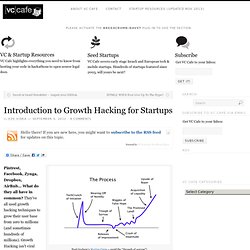
They’ve all used growth hacking techniques to grow their user base from zero to millions (and sometimes hundreds of millions). Growth Hacking isn’t viral marketing (although viral marketing is part of it). Growth Hacking comes to solve a very common problem in consumer startups: getting to the first x thousand/million users quickly once the product has launched and the hype has passed. The term “Growth Hacking”, invented by Sean Ellis, and made popular by Andrew Chen, a Silicon valley marketer and entrepreneur, is a combination of two disciplines – marketing and coding: Working Backwards. In the fine grained services approach that we use at Amazon, services do not only represent a software structure but also the organizational structure.
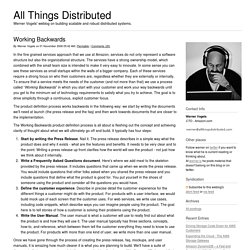
The services have a strong ownership model, which combined with the small team size is intended to make it very easy to innovate. Want to Know How VC’s Calculate Valuation Differently from Founders? Back in 1999 when I first raised venture capital I had zero knowledge of what a fair term sheet looked like or how to value my company.

Due to competitive markets we ended up with a pretty good term sheet until we needed to raise money in April 2001 and then we got completely screwed. It was accept the terms or go into bankruptcy so we took the money. Those were the dog days of entrepreneurship. But the truth is that I didn’t really understand just how screwed I was until years later when I finally understood every term in a term sheet and more importantly I understood how each term could actually be used to screw me. Things like “participating preferred stock” in legalese unsurprisingly never actually call out, “hey, this is the participating preferred language.” Back then VentureHacks didn’t exist. S $1M Fundraising: Lessons Learned about Pitching Investors from a First-Time Entrepreneur at Udemy. “Raising Capital for Startups” on Udemy Udemy recently closed a $1 million financing from a syndicate of angel investors.
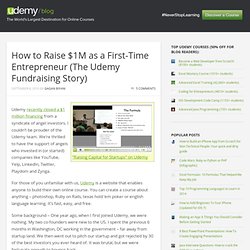
I couldn’t be prouder of the Udemy team. We’re thrilled to have the support of angels who invested in (or started) companies like YouTube, Yelp, LinkedIn, Twitter, Playdom and Zynga. For those of you unfamiliar with us, Udemy is a website that enables anyone to build their own online course. You can create a course about anything – photoshop, Ruby on Rails, texas hold ‘em poker or english language learning. Les critères d’investissement d’un Business Angel engagé. Cette semaine, j’ai décidé de vous parler de mon process de sélection de projets, en fait surtout d’équipes, dans lesquelles j’investis.

Au début de mon expérience de business angel, comme dans le recrutement de collaborateurs (trices) chez Juste à temps d’ailleurs, je fonctionnais surtout à l’affectif. Et, à force de désillusions, je me suis remis en cause, moi aussi. Schématiquement, j’ai évolué vers : Petit point technique sur les levées de fonds. Je rencontre pas mal d’entrepreneurs avec qui je dois passer quelques minutes à reprendre les explications « techniques » à la base pour ce qui concerne tout ce qui entoure une levée de fonds.
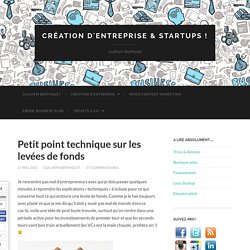
Comme je le fais toujours avec plaisir et que je me dis qu’il doit y avoir pas mal de monde dans ce cas-là, voilà une idée de post toute trouvée, surtout qu’on rentre dans une période active pour les investissements de premier tour et que les seconds tours vont bon train actuellement (les VCs ont la main chaude, profitez-en !) Comment (et combien) valoriser une startup ? Ah ! Voilà un sujet qui a déjà fait couler beaucoup d’encre et qui pourtant continue d’animer le petit milieu des entrepreneurs… Combien vaut ma boîte ?
Chris dixon's blog / Notes on raising seed financing. Last night I taught a class via Skillshare (disclosure: Founder Collective is an investor) about how to raise a seed round. After a long day I wasn’t particularly looking forward to it, but it turned out to be a lot of fun and I stayed well past the scheduled end time. I think it worked well because the audience was full of people actually starting companies, and they came well prepared (they were all avid readers of tech blogs and had seemed to have done a lot of research). I sketched some notes for the class which I’m posting below. Www.strategie-aims.com/events/conferences/4-xxeme-conference-de-l-aims/communications/1434-le-business-model-en-tant-que-variable-explicative/download.
L'association loi 1901 pour "porter" la béta gratuite permanente. Blogging Innovation » 10 B2B Sales & Marketing Metrics Worth Tracking. The fine folks at Focus.com let me do a Webinar on this topic several months ago, but I wanted to summarize what I consider to be ten fundamental B2B sales & marketing metrics here as well. You can get an on-demand recording of the full Webinar here, but below (with some qualifying thoughts & questions) are the ten metrics. Quick Disclaimer: Just because you can track it, doesn’t mean you should. Just because you can track it, doesn’t mean it’s important. Blogging Innovation » 50 Awesome Quotes on Possibility.
“Start by doing what’s necessary; then do what’s possible; and suddenly you are doing the impossible.” – St. I love metrics ! Allez, ça fait bien un mois ou deux que je n’ai pas tapé sur l’un de mes clous préférés : les métriques, les chiffres, le reporting, et tout et tout. Startup Metrics. A post by Fred Wilson pointed me to Dave McClure's Startup Metrics presentation. This is a great presentation and one that I'm going to point out to startup / early stage company CEOs. Normally, when I am talking to the founder of any startup trying to figure out what they need to do, one of the things I always try to do is understand their business at its core.
In many cases, I can break it down into: Designing startup metrics to drive successful behavior. Great companies are almost always run by great management teams. And great management teams know that the only way to improve a process is to start by measuring it. Good metrics should also be actionable, and drive successful behavior. Faut il abandonner les Business Plan ?
Launching Tech Ventures: Part IV, Readings. Entrepreneurs: Ideas are Worthless, Execution is Gold. Over the last few months, I’ve come into contact with a bunch of budding new entrepreneurs (like myself) hungry to start a startup and it’s very surprising to see the attitude they approach the challenge with. Too often, new entrepreneurs put way too much effort and focus on the idea. They think that the value of a business is solely behind the idea it’s built on, but there’s little to no truth in that. Let me explain. Yes, ideas are important. You’re better off pushing an amazing product, rather than a good or sub-par one, so having a great solid foundational idea does accelerate the whole process somewhat. For example, let’s take a look at one of the hottest startups around at the moment, MailChimp . Comprendre le fonctionnement des startups pour améliorer leur réussite. Par Hubert Guillaud le 19/04/12 | 6 commentaires | 2,735 lectures | Impression.
What Makes an Entrepreneur (2/11) – Street Smarts. I started the series talking about what I consider the most important attribute: Tenacity. 2. Street Smarts - OK, so you’re a tenacious person – you never give up. Well obviously that’s meaningless if your startup idea sucks. Blogging Innovation » Ten Rules for Starting a Business.